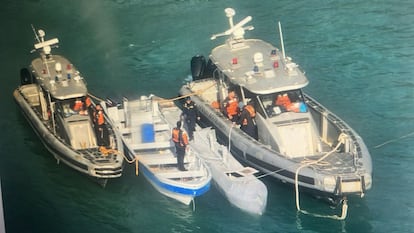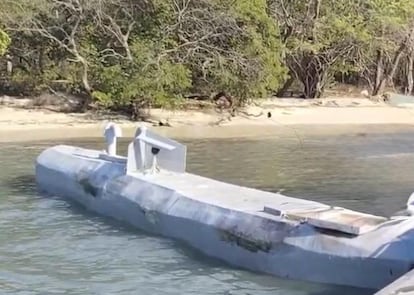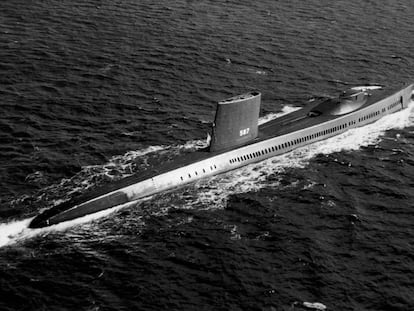Colombian Navy intercepts narco-submarine featuring technology that made it hard to track
The remote-controlled submersible, with the capacity to transport over 1.5 tons of cocaine, is the first of its kind located in national waters. It had antennas, surveillance cameras and a Starlink modem to link to satellite internet


The Colombian Navy on Wednesday reported it has intercepted a remote-controlled submarine in the Caribbean capable of carrying more than 1.5 tons of cocaine and with a range of up to 800 miles. The discovery marks the first time such a vessel is found in Colombian waters. Authorities have warned of the adoption of much more advanced technological systems by drug trafficking networks around the world, which represents “a growing challenge for international maritime security.”
The vessel is much smaller than a typical submarine. It is similar in length to a speedboat, has a uniform gray coating, and was not loaded with drugs at the time it was found. The Navy indicated that the discovery was made on April 1 near Tayrona National Park, in the Colombian Caribbean. The submersible was equipped with two antennas (one external and one located on the upper deck with fiberglass protection) and a Starlink modem, which allows it to communicate via satellite internet. This feature facilitates real-time monitoring and control.
The vessel also had two surveillance cameras: one on the outside, providing a real-time view of the submarine’s trajectory and potential obstacles, and another internal one to monitor the engine and transmission.
Juana Cabezas, a researcher at the Institute for Development and Peace Studies (Indepaz), told AFP that, since at least 2017, Mexican drug cartels operating in Colombia began hiring engineers and technology experts to develop unmanned submarines. “The idea was that they would pass through the Pacific and automatically unload drugs, so that people could pick them up and put them in other unmanned submarines,” she said.

The finding is part of a global trend already identified by authorities. Throughout the first half of this year, at least 10 vessels with similar characteristics have been detected in various regions of the Americas. All of them were equipped with technology that allows them partial autonomy and makes them difficult to track by radar. The trend, according to the Colombian Navy, reflects “an evolution in the logistical capabilities of drug trafficking,” which seeks to improve on its traditional operating methods.
The operation was part of the Orion Naval Campaign, a multinational strategy involving 127 institutions and 10 multilateral organizations from 62 countries around the world. Along with the information on the discovery of the semi-submersible, authorities provided data on seizures made by the Orion Strategy in the first six months of this year worldwide: 2,326 tons of narcotics, including more than 327 tons of cocaine (equivalent to 818 million doses), 211 tons of marijuana (34 million doses), 12 tons of hashish, 118 kilograms of methamphetamines, and 452 kilograms of heroin. Additionally, some 1,770 tons of marijuana have been found in cultivation sites in Brazil and Paraguay.
Sign up for our weekly newsletter to get more English-language news coverage from EL PAÍS USA Edition
Tu suscripción se está usando en otro dispositivo
¿Quieres añadir otro usuario a tu suscripción?
Si continúas leyendo en este dispositivo, no se podrá leer en el otro.
FlechaTu suscripción se está usando en otro dispositivo y solo puedes acceder a EL PAÍS desde un dispositivo a la vez.
Si quieres compartir tu cuenta, cambia tu suscripción a la modalidad Premium, así podrás añadir otro usuario. Cada uno accederá con su propia cuenta de email, lo que os permitirá personalizar vuestra experiencia en EL PAÍS.
¿Tienes una suscripción de empresa? Accede aquí para contratar más cuentas.
En el caso de no saber quién está usando tu cuenta, te recomendamos cambiar tu contraseña aquí.
Si decides continuar compartiendo tu cuenta, este mensaje se mostrará en tu dispositivo y en el de la otra persona que está usando tu cuenta de forma indefinida, afectando a tu experiencia de lectura. Puedes consultar aquí los términos y condiciones de la suscripción digital.
More information
Archived In
Últimas noticias
Sydney Sweeney, the actress praised by Trump: ‘Women are up against what society wants them to be’
The Bolsonaro surname: An advantage or liability in Brazil’s 2026 presidential elections?
Raúl Rocha, from jet-setting with Miss Universe to arms trafficking and fuel theft
80,000 barrels of Mexican oil sent to Cuba: Havana drawn into the US–Mexico clash
Most viewed
- Reinhard Genzel, Nobel laureate in physics: ‘One-minute videos will never give you the truth’
- Pablo Escobar’s hippos: A serious environmental problem, 40 years on
- Charles Dubouloz, mountaineering star, retires at 36 with a farewell tour inspired by Walter Bonatti
- Why we lost the habit of sleeping in two segments and how that changed our sense of time
- The fall of a prolific science journal exposes the billion-dollar profits of scientific publishing










































